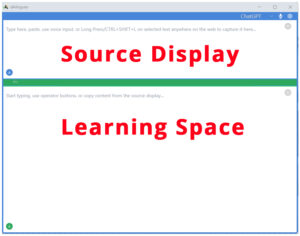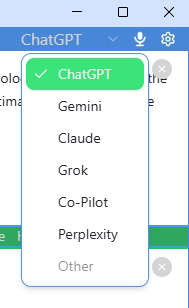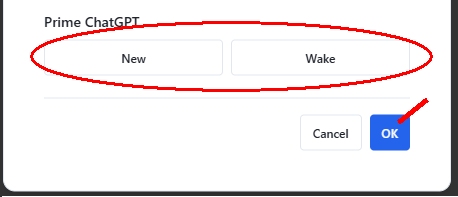
The dAilogue Chrome Extension is an alpha phase extension intended to demonstrate the value of providing a learning optimized interface to the major Ai systems. With the extension learners can type, talk, paste or select text on virtually any page on the web and quickly indicate what they would like to learn about it or how they would like it transformed (distilled, simplified (by age), expanded (by age) , re-represented in numerous ways, argued with) or translated into any language.
| Special note 8-9-25 I released v1.4 (via download below) most of its Keyword functions don’t work as I am rebuilding the entire keyword system. However this version does use the next iteration UI and all the AI primers work. Stay tuned.
I – Install Chrome Extension 1 – Right click on this link: Download and save the file to any folder. |

3 – Turn on Developer Mode (1)
4 – To install extension: click on Load Unpacked (2)
5 – Navigate to and open the downloaded and unzipped file “extension” (from step 2 above)

II – Enable / Pin Extension
Once installed, click on the extensions control icon (1) located in the right corner of Chrome. Click the dailogues (2) pin icon to pin the extension to the browser. The dAilogues Icon (currently a square with the letter “d” in it) should now be visible on your browser’s extension toolbar.
![]()
III – Getting Familiar with the Extension

Click the extension’s toolbar icon ![]() . Note that the app has two distinct zones: the Source Display and the Learning Space.
. Note that the app has two distinct zones: the Source Display and the Learning Space.
The Source Display
The Source Display (#4) is where content comes into the app. You can type it in, speak it in, paste it in from any source, or you can select text on any page of the web and by long pressing your mouse (or finger) or by using the CTRL+SHIFT+L key combination, the selected text will be scooped up and pasted in for you. You can edit the content of the Source Display. The small grey (X) button in top right of the window will clear all content. When you are satisfied that your content is ready to engage Ai the small green down-arrow button in bottom left of the window will copy its content to the Learning Space.
The Learning Space
Once the text is copied into the Learning Space you can add to or edit it (type, voice, paste) or proceed to using the Learning Assistance Menu: The “Lenses”, “Vectors”, “Mindsets”, “Assessments”, and, optionally, “Languages” (on the green menu bar) to package the text and send it to an AI for processing.
IV – Getting Set Up
On the top blue border of the app are three controls:

1) the AI selector – Click to choose the AI you prefer to use for the current session.
 2) The Microphone – Click to establish an insertion point in either the Source Display or Learning Space and then click the microphone to begin voice to text entry.
2) The Microphone – Click to establish an insertion point in either the Source Display or Learning Space and then click the microphone to begin voice to text entry.
3) Settings – Click to open the settings panel where you can choose “App Settings” to prime the AI you chose, and enable and disable convenient features. Or you can choose “Learning Support Settings” where you can create a personal toolbox for how you want to AI to help you learn (Lenses, Vectors, Mindsets, Critics, and Languages)
V – Primers
The dAilogue extension works in tandem with a special set of instructions called “primers” that make the various AIs “dAilogue ready and able”. There are two main primers, one for starting new dAilogue Chats and one for resuming existing dAilogue Chats.
To load the primers.
1 – Open a new or existing chat with your preferred AI (log in if you have an account)
2 – Click on the ![]() dAilogues icon in the extension toolbar.
dAilogues icon in the extension toolbar.
3 – Select the AI you want to use for this session
4 – Open settings
5 – Click the “New” or “Wake” button depending on whether you are starting a new dAilogue Chat or are wanting to refresh or wake up an already existing one.

In either event you will see the target AI acknowledge that it is ready with the simple message “Now in dAilogue Mode”.
Using the Extension (Note: actual app changes are happening faster than this page can keep up – feel free to play around with the app. Also: the app is currently unconcerned with how it looks to learners – the app will later be “skinned” for different kinds of learners/uses (see Page 29 of EPL)
Go to any webpage and drag your mouse to select text. Once selected keep mouse button pressed (long press 1 sec) and the dAilogue box will open the text you selected will appear in the upper window of the box (Source Display).
Pressing the green button will copy the text to the lower window of the box (Learning Space). You can also select only a part of the text in the Source and only it will be copied to the Learning Display.
—————- here is where you are on your own for now…. 🙂
You can now use any of the Meaning Guides (Explore through Translate) in any combination anywhere within the content in the Learning Display. Clicking any button will place its meaning operator instruction wherever you indicate (insertion point). You can also type any questions or edit in any way helpful the content in the Learning Display. When ready, pressing the green button (3) will push the content and instructions into an open ChatGpt tab and initiate ChatGpt following the meaning operating instructions embedded in the pushed content.
Note: this assumes that ChatGpt is running one of our Primers. See primers.
In addition to the meaning operators, the Help button will open THIS page in a browser tab, and the Settings Icon (2) allows you to set a) the default language for translation b) the default age for the Simplify and Expand buttons.
Special Case: when using the extension on a ChatGpt page the dAilogue box will have two additional buttons: History and Context both of which can be used to summarize a chat’s history or the context of the current point.
Here’s a quick-reference guide to the keyword system you can use during dAilogues. These keywords modify how responses behave — either by changing the way ideas are expressed or by triggering specific types of help.
🔑 Core Expression Buttons
Use to clarify, restructure, or extract meaning.
| Button | What It Does | Example Use |
|---|---|---|
reflect |
Mirrors your meaning back without altering it | [reflect] I think the user was unclear |
represent |
Restates clearly and structurally | [represent] Here's what I meant... |
essence |
Extracts the core idea succinctly | [essence] This paragraph feels wordy |
🧠 Perspective-Changing Buttons
Use to deepen, challenge, or open up new thinking.
| Button | What It Does | Example Use |
|---|---|---|
counterpoint |
Offers a thoughtful contrast or alternative view | [counterpoint] Should we automate that? |
learn |
Expands for deeper understanding | [learn] Why do customers resist updates? |
explore |
Opens up new angles or follow-up questions | [explore] How else could we resolve this? |
📚 Contextual/Structural Button
Use to manage flow or meta-structure of the dAilogue.
| Button | What It Does | Notes |
|---|---|---|
point context |
Shows where a point fits in broader discussion | Helps track meaning across messages |
chat history |
Summarizes the relevant past conversation | Only works as standalone |
share |
Adds footer for sharing a specific message | Only works as standalone |
🧒 Age-Based Simplification / Expansion
Use to reframe content at a specific developmental level.
| Button | What It Does | Format |
|---|---|---|
simplify (x) |
Re-expresses concept for child of age x |
[simplify (8)] |
expand (x) |
Builds up idea from scratch as if for child age x |
[expand (10)] |
⚠️ These override all default phrasing and use age-appropriate vocabulary, structure, and examples.
🌐 Translation Button
| Button | What It Does | Format |
|---|---|---|
translate-(language) |
Translates the most recent or tagged content | [translate-spanish] |
🧩 You can combine Buttons, like:[reflect][counterpoint][simplify (9)] Why do users hesitate to click "Update now"?
→ This will mirror your intent, offer a thoughtful contrast, and explain the whole thing as if to a 9-year-old.
Use these anytime. I’ll respond accordingly. Ready when you are.

Comments are closed.